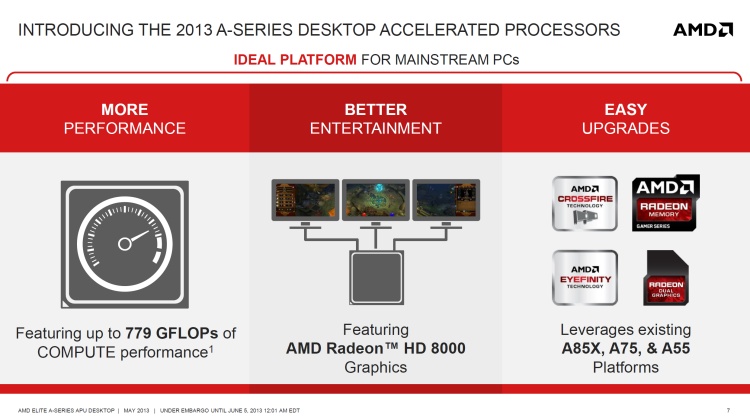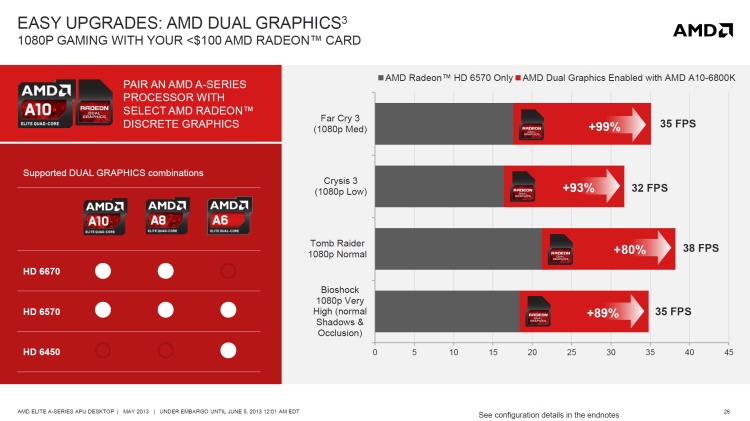Final Thoughts
So what does Richland bring to the table? Honestly, not much. This minor refresh essentially bumps up the clock speeds of each model from the previous generation Trinity series. A little bit of overclocking isn't necessarily a bad thing, except for the fact that in this case you're paying AMD extra for it.
The A10-6800K has an MSRP of $142, while the slightly slower A10-5800K has been selling for just $129 over the past 6 months. That means consumers would be paying 10% more for a processor that is clocked just 8% higher and going by our tests it even struggles to make up that margin.
There were some scenearios under which the A10-6800K showed noticeable performance gains over the A10-5800K, namely in our encoding benchmarks, where it was between 10 and 14% faster.

Moreover, when it came to GPU performance things are virtually unchanged. Despite the higher nomenclature, AMD's Radeon HD 8670D performance was identical to that of the 7660D featured in the A10-5800K.
When compared to the Core i5-3450 ($190), the A10-6800K is 25% cheaper, so an Ivy Bridge Core i3 chip such as the i3-3225 ($140) would make a better comparison – we didn't have one at the time of testing, unfortunately.
In any case, compared to the Core i5-3450, AMD's processor was 28% slower on average in our applications test and again 28% slower in our encoding test. In other words, the A10-6800K only barely loses out to the Core i5-3450 in a price vs. performance perspective. At least when comparing CPU performance. When it comes to integrated graphics AMD had no problem slaughtering the Core i5-3450 in every game tested.

Where the A10-6800K falls flat on its backside is power consumption, however. The chip consumed 59% more power than the Core i5-3450 and that is only taking into account CPU consumption, not GPU.
As for the lower end A4-4000, we found it to be a rather lack luster product. Clocked at just 3.0GHz with two cores and a 1MB L2 cache this thing leaves much to be desired. In every application and encoding test we ran it was put to death by the Celeron G1610. The latter was also much faster in games such as Far Cry 3 when using a discrete graphics card, and even when relying on the integrated GPU the A4-4000 wasn't much faster at times.
Once again, the final nail in the coffin was power consumption. Here the A4-4000 consumed just as much power as the Core i5-3450 under load, and 53% more than the Celeron G1610. Considering the chip is just $5 less than the Celeron G1610, AMD isn't offering much of a bargain here.
Frankly, the A4-4000 is just too gutless and far too power hungry to even consider in our opinion. If you want to spend less than $50 on a CPU, the Celeron G1610 is a much faster and considerably more fuel efficient choice.
The A10-6800K was another story. CPU performance is good enough, but GPU performance is excellent. Although power consumption was up there it's not exactly a deal breaker – and certainly not as ridiculous as the A4-4000 in terms of watts vs. performance. The main downside is that it costs more than the A10-5800K it replaces. Had it come in at the same price we would have been a little intrigued, but right now it's just not worth getting too excited about.
AMD A10-6800K Scorecard
Pros: Good enough CPU performance, excellent GPU performance.
Cons: Higher power consumption than its faster Intel counterparts. Priced higher than the A10-5800K it replaces yet it offers only a slight CPU performance gain.
AMD A4-4000 Scorecard
Pros: Slightly better GPU performance than competitors in its price range – but that's not saying much for a sub-$50 chip.
Cons: Considerably slower CPU performance and higher power consumption than Intel's Celeron G1610, which is just $5 more.
